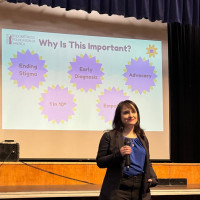
The most extensive study ever conducted on endometriosis genetics has revealed a shared genetic basis for endometriosis and other types of pain, including migraine, back pain, and multisite pain. It also provides a clear distinction between ovarian endometriosis and other forms of the disease.
Celmatix, based in New York City, is a preclinical-stage and leading women’s health biotech focused on ovarian biology. Founder and CEO Piraye Yurttas Beim called the study “grassroots” and “unprecedented.”
“I think what was magical about this was the way industry and academia across the globe came together to make this happen,” Yurttas Beim said. “It’s a wonderful example of how they were able to make a big difference for women, even in an environment where there’s a lot of disparity.”
Yurttas Beim noted two significant results from the study.
“I think one is that ovarian endometriosis, from a genetic standpoint, looks like a very distinct subtype and quite a unique disease compared to other forms of endometriosis,” she said. “That could open up some additional research avenues and impact treatment long term.”
The other finding she noted was the connection between endometriosis and chronic pain conditions, which she said legitimizes the pain that women have been reporting and clinicians have been aware of for years.
“It really gives us a scientific basis and understanding of that pain,” Yurttas Beim said. “Other pain conditions have other interventions, are better funded, and are more recognized as debilitating, so I think this study will really help to elevate endometriosis in that respect.”
Yurttas Beim said endometriosis has been niched as a reproductive condition, and that shouldn’t be the case.
“We have women who have had hysterectomies and oophorectomies—they have virtually none of their reproductive organs left—but are still living in pain, and that makes no sense if it’s just a reproductive condition,” she said. “This is an inflammatory disease, a condition that can cause intermittent or unrelenting pain, and it needs to be treated that way.”
Dr. Dan Martin, scientific and medical director for EndoFound, called this a “landmark study of the genetics of endometriosis” and said the genetic difference between ovarian endometriosis and other forms of endometriosis “is unanticipated but compatible with Nisolle and Donnez's 1997 classification of endometriomas as one of three types of endometriosis.
“Pain requires appropriate medical, complementary, and surgical management,” Dr. Martin said. “Patients are individuals; some respond to different treatments. Knowing the genetic differences may help us determine who will respond to specific treatments.
As for what this study could mean in the near future, Yurttas Beim hopes it will improve earlier detection of endometriosis and advance existing treatments while helping to create new ones.
“I think we’ll be able to look back in five years and understand that this study opened up better diagnostics where we can identify women at risk earlier,” Yurttas Beim said. “So now, when they start experiencing that pain, their doctor can say, ‘I see here you tested positive for these risk factors and I’m going to take your pain more seriously. I’m not going to tell you that it’s just part of being a woman.’”
The complete study, “The genetic basis of endometriosis and comorbidity with other pain and inflammatory conditions,” can be found at https://www.nature.com/articles/s41588-023-01323-z









